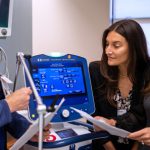For people living with cancer, exercise can improve quality of life, sleep and energy levels and help with side effects of cancer treatment. And even though physicians and oncology researchers agree about these benefits, a recent survey found that only 15% of cancer patients had been referred to an exercise program.
“Clearly, we have a disconnect,” said Dr. Kathryn Schmitz, an exercise oncology researcher and professor of medicine at the University of Pittsburgh School of Medicine.

Dr. Kathryn Schmitz
As director of UPMC Hillman Cancer Center’s Exercise Oncology efforts, Schmitz aims to solve this disconnect by making exercise and rehabilitation referrals standard of care for cancer patients.
In a new study, published in Supportive Care in Cancer, Schmitz and her team developed an approach to implement exercise referral screening into cancer care, which led to 45% of patients being connected to exercise programs or rehabilitation services.
“There’s a viewpoint that the only thing that matters about someone with cancer is treating their tumor, but we need to think about caring for the whole patient,” said Schmitz. “All patients receive testing to figure out the best course of treatment, whether that’s chemotherapy or radiation, for example, but I believe that every patient should also be evaluated to determine whether they would benefit from an exercise program.”
Toward this goal, the researchers developed an electronic triage tool that included 23 questions about patients’ daily activities, recent symptoms and confidence with exercise. The team then worked with nursing and cancer center leadership to integrate the tool into cancer care by offering it to patients at their second chemotherapy infusion appointment.
Of 501 patients who were offered the survey during the study period, 85% completed it. Based on their responses, these patients were referred to one of three levels of care: community-based exercise, clinically supervised exercise or cancer rehabilitation.
“There are a lot of assumptions about what we mean when we say ‘exercise,’” said Schmitz. “But the definition of exercise is very broad and can mean a lot of different things. There isn’t really a way of doing exercise wrong: If you’re not motionless, you’re doing it right.”
According to Schmitz, exercise includes weightlifting, walking, yoga, simple balance exercises or even movement performed while sitting in a chair.
“Our program attempts to meet people where they are,” said Schmitz. “If we’re working with an active 30-year-old, we’re going to push them; if we’re working with someone in their 70s, we’re going to find something that works for them.”
Of 391 patients who completed the survey, 176, or 45%, accepted referrals to exercise or rehabilitation, which is triple the previously reported rate.
Schmitz and her team are now working to expand the referral program into 59 community-based clinics across Hillman Cancer Center’s network. They’ve also integrated a more streamlined version of the survey into patient medical records, so it is included in routine visits and can be updated to meet a patient’s current needs. Already, they’ve seen a boost in referral rates to 50%, but they hope to see this value continue to grow.
In the future, they aim to offer patients more options for physical activity, including telehealth exercise sessions.
“I wanted to make sure the end of the story wasn’t publishing the paper,” Schmitz adds. “The end of the story is making the program happen in all clinics across the United States so that the benefits of exercise are available to every person who is diagnosed with cancer.”
Kaleigh Connors is a Ph.D. candidate in the University of Pittsburgh School of Public Health Department of Infectious Diseases and Microbiology. She is participating in the UPMC Science Writing Mentorship Program.









